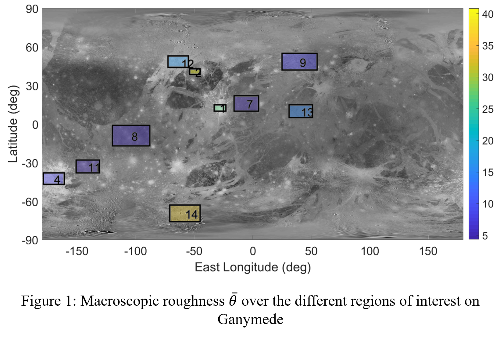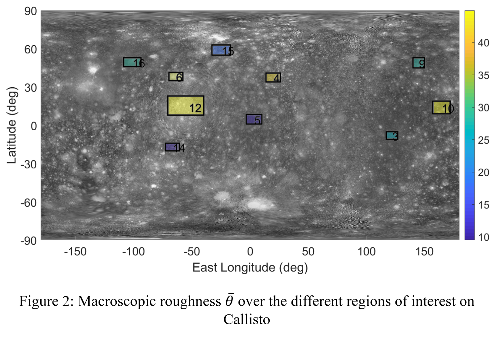Regional photometric study of Ganymede and Callisto
- 1Université Paris-Saclay, CNRS, GEOPS, 91405, Orsay, France
- 2ESAC, European Space Agency, Madrid, Spain (ines.belgacem@esa.int)
- 3Airbus Defence & Space, Toulouse, France
Abstract
We carried out a regional study of Ganymede and Callisto’s photometry by estimating the parameters of the Hapke photometric models on a handful of regions of interest. We found that the photometry was diverse across the surface and highlighted areas with a distinct behavior that could indicate localized activity on Ganymede
Introduction
Jupiter’s icy moons are at the center of future space exploration missions such as ESA’s JUpiter ICy moons Explorer [1] and NASA’s Europa Clipper [2]. Ganymede, in particular, will be the primary target of the JUICE mission. Knowledge of the surface of Ganymede and Callisto is paramount to best plan the mission, help with navigation [3] and understand the its geology. In this study, we focus on the photometry of the surface and how we can describe it using the Hapke photometric model [4].
1. Dataset
We use images from the Voyager probes dataset taken with the Imaging Science System (ISS) [5] and from the New Horizons spacecraft taken with the LOng Range Reconnaissance Orbiter (LORRI) [6] with a ground resolution between 10 km and 30 km at the subspacecraft point. All Voyager images are limited to the clear filter.
2. Method
We need two elements to carry out this study: the reflectance and the geometry of observation. The first can be obtained after radiometric calibration of the images. The second necessitates accurate projections of each pixel.
2.1 Correction of metadata
We simulated images with SurRender [7] and compared those simulations to the real images to correct for spacecraft pointing and moon attitude. Additional distortion and distance corrections were needed and implemented on the Voyager images [8].
2.2 Model and Bayesian inversion
For this study we are considering the Hapke model detailed in Hapke, 1993 [4]. Six parameters are estimated: b, c, ω, θ, h and B0.
We have developed an inversion tool using a Bayesian approach based on previous work done on Mars [9, 10]. No a priori knowledge of the parameters were inferred except for their physical domain of variation. We also include in the model uncertainties on the absolute level reflectance (radiometric uncertainties) to correct for potential bias. This work is detailed in our previous study of Europa [11].
3. Results
3.1. Ganymede's regional photometry
We realized a regional photometric study of 15 areas of Ganymede with a very limited dataset of 16 images matching our criteria (see section 1) for which we corrected the metadata (spacecraft position and orientation) and radiometric calibration discrepancies.
We found that most of our areas are consistent with a global backscattering behavior of the surface with two notable exceptions - ROIs #2 and #4 (see fig. 1). They are situated in the polar latitudes, respectively in the north and in the south hemispheres. They are both very bright and rough and exhibit a strong and narrow forward scattering. This could be due to them being particularly favorable areas for ice redistribution at the poles or signs of possibly localized activity.

3.2. Callisto's regional photometry
We have estimated the photometric behavior of 16 regions of interest on Callisto's surface using 47 images per our selection criteria (see section 1).
Our phase coverage of Callisto is sparse, especially on the leading side, which makes it difficult to have reliable results. However, we have obtained fairly well constrained results for some areas. We have noted that θ - although in average higher than on Europa and Ganymede - shows some variation. ROI #2 is the palimpsest at the center of crater Valhalla. It is the brightest and roughest area that we sampled across Callisto's surface.
Although Callisto is the darkest of the three icy Galileans, we have identified a couple of bright and rough areas that show a strong and narrow forward scattering. We think they might be fields of knobs with frost on the crest as it is common to find frost deposits on topographical highs on Callisto [12].

Conclusion
The preliminary results of this study are very encouraging and show areas of particular interest that could be targeted by future missions. Overall, the general trends of our results are consistent with past integrated photometric studies [13, 14].
We plan on extending this work with more photometric models to find one that best describe the local photometry of both Ganymede and Callisto.
Acknowledgements
This work is supported by Airbus Defence & Space, Toulouse (France), the "IDI 2016" project funded by the IDEX Paris-Saclay, ANR-11-IDEX-0003-02 and the INSU, CNRS and CNES through the Programme National de Planétologie (PNP). Participation to EPSC 2020 is supported by ESAC.
References
[1] O. Grasset et al. An ESA mission to orbit Ganymede and to Characterize the Jupiter system, Planetary and Space Science, 2012
[2] Phillips and Pappalardo, Europa Clipper mission concept: Exploring Jupiter’s ocean moon, Eos, Transactions American Geophysical Union, 2014.
[3] G. Jonniaux et al. Autonomous vision-based navigation for JUICE. IAC, 2014
[4] B. Hapke, Theory of reflectance and emittance spectroscopy. Topics in Remote Sensing, Cambridge University Press, 1993
[5] A.Cheng , NEW HORIZONS Calibrated LORRI JUPITER ENCOUNTER V2.0, NH-J-LORRI-3-JUPITER-V2.0, NASA PDS, 2014.
[6] M. Showalter, VG1/VG2 JUPITER ISS PROCESSED IMAGES V1.0 VGISS_5101-5214, NASA PDS, 2013.
[7] R. Brochard et al. Scientific Image Rendering for Space Scenes with SurRender software, IAC, 2018.
[8] I. Belgacem et al. Image processing for precise geometry determination, under revision for Planetary and Space Science.
[9] J. Fernando, F. Schmidt, and S. Douté, Martian Surface Microtexture from Orbital CRISM Multi-Angular Observations: A New Perspective for the Characterization of the Geological Processes, Planetary and Space Science, 2016.
[10] F. Schmidt and S. Bourguignon, Efficiency of BRDF sampling and bias on the average photometric behavior Icarus, 2019.
[11] I. Belgacem et al. Regional study of Europa’s photometry, Icarus, 2019.
[12] J. M. Moore et al. Callisto in : Jupiter : The planet, Satellites and Magnetosphere, Cambridge University Press, 2004.
[13] B. J. Buratti, Photometry and Surface Structure of the Icy Galilean Satellites, Journal of Geophysical Research, 1995.
[14] D. L. Domingue and A. Verbiscer, Re-Analysis of the Solar Phase Curves of the Icy Galilean Satellites, Icarus, 1997.
How to cite: Belgacem, I., Schmidt, F., and Jonniaux, G.: Regional photometric study of Ganymede and Callisto, Europlanet Science Congress 2020, online, 21 Sep–9 Oct 2020, EPSC2020-83, https://doi.org/10.5194/epsc2020-83, 2020.

